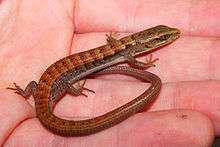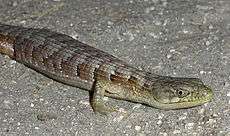Southern alligator lizard
| Southern alligator lizard | |
|---|---|
 | |
| Scientific classification | |
| Kingdom: | Animalia |
| Phylum: | Chordata |
| Class: | Reptilia |
| Order: | Squamata |
| Family: | Anguidae |
| Genus: | Elgaria |
| Species: | E. multicarinata |
| Binomial name | |
| Elgaria multicarinata Blainville, 1835 | |
.png) | |
The Southern alligator lizard (Elgaria multicarinata) is a common species of lizard native to the Pacific coast of North America.[1] It ranges from Baja California to the state of Washington and lives in a variety of habitats including grasslands, chaparral, forests, and even urban areas.[1][2] In dry climates, it is likely to be found in moist areas or near streams.[1]
Taxonomy and etymology
The generic name Elgaria is possibly named for an "Elgar" or a pun on "alligator." The species name multicarinata refers to the keeled scales characteristic of this species.[3] The common name "alligator lizard" is a reference to the fact that the back and belly scales of these lizards are reinforced by bone, as they are in alligators.[4]
Three subspecies can be distinguished: the California alligator lizard (E. m. multicarinata), the San Diego alligator lizard (E. m. webbii), and the Oregon alligator lizard (E. m. scincicauda).[2]
Description

The southern alligator lizard ranges from 3 to 7 inches (7.3 - 17.8 cm) in length (snout to vent). Including tail, it can reach a foot in length (30 cm).[2] These lizards have a round thick body with small legs and a long somewhat prehensile tail that can be twice as long as the lizard's body.[1] Like many lizards, this species can drop its tail if attacked, possibly giving it a chance to flee. These lizards also live on average 10 to 15 years, but is probably shorter in captivity. [1]
The color of this species is variable, and can be brown, grey, green, or yellowish above, often with red blotches on the middle of the back. Usually there are between 9 and 13 dark bands on the back, sides, and tail, with adjacent white spots. These bands can be pronounced or covered with reddish or yellowish color.[2][3]
The scales of these lizards are keeled on the back, sides, and legs. They have 14 rows of scales across the back at the middle of the body. A band of smaller granular scales separates the larger scales on the back and stomach, creating a fold along each side of the animal. These folds allow the body to expand to hold food or eggs.[3]
Range and habitat
The southern alligator lizard is native to the Pacific coast of North America, ranging from the state of Washington to Baja California. These lizards can be found across many diverse habitats, including grassland, open forest, chaparral, suburban and urban areas, and even into the desert along the Mojave River.[3][5] This species is particularly common in foothill oak woodlands, and is often found hiding under rocks, logs, or other surface cover.[3]
Diet
These lizards eat small arthropods, slugs, lizards, small mammals and occasionally young birds and eggs.[2]
Behavior and reproduction

These lizards can frequently be found near human habitation, and are often seen foraging in the mornings and evenings. They are often found in or around suburban yards and garages.[3] Alligator lizards are notable for their vicious self-defense, and will bite and defecate if handled.[1]
Mating occurs in Spring, typically from April to May, though in warmer regions this species will breed year-round.[3][4] Eggs are usually laid between May and June and hatch during late summer and early fall.[3] Females lay two clutches of eggs per year, often in decaying wood or plant matter to keep them warm. Females will guard the eggs until they hatch.[4]
See also
References
- 1 2 3 4 5 6 "Southern alligator lizard". San Diego Zoo Factsheets. San Diego Zoo. October 2008. Retrieved June 24, 2013.
- 1 2 3 4 5 Stebbins, Robert (2003):331. A Field Guide to Western Reptiles and Amphibians, Houghton Mifflin. ISBN 0-395-98272-3
- 1 2 3 4 5 6 7 8 "California Alligator Lizard - Elgaria multicarinata multicarinata". www.californiaherps.com. Retrieved 2015-12-28.
- 1 2 3 "Sacramento Zoo -- Alligator Lizard".
- ↑ "California Wildlife Habitat Relationships System -- Southern Alligator Lizard". California Department of Fish and Wildlife.
External links
| Wikimedia Commons has media related to Elgaria multicarinata. |
